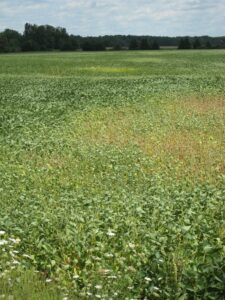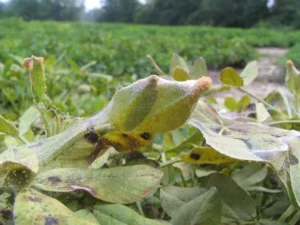I’ve received a few calls about twospotted spider mite infestations in soybeans in West Tennessee. Spider mites usually are a minor issue in soybeans and I’ve only seen two instances in 10 years that warranted treatments for mites in beans, both were in severe droughts. Spider mite infestations in soybeans, like cotton, often start from the edge of fields. Unlike cotton, infestations don’t result in reddening leaves but a gradual transition from green to light green to yellow to brown. In a normal year, soybeans have the ability to compensate for spider mite injury and most infestations often go unnoticed or mites never gain a foothold due to ample rainfall, predators or entomopathogens that control them before they become a problem. In drought years, when alternative weed hosts have been killed with herbicides or desiccated by lack of water, soybeans become an attractive host for spider mites.

Mite populations, in soybeans, often reach very large numbers before they are discovered. This is, in part, due to people not looking and assuming that desiccated brown leaves are a bad spot in the field, charcoal rot or generally poor area that beans are struggling in. Under West Tennessee’s current conditions, brown/yellow patches of soybeans should be investigated for presence of mites and not just assumed its from drought. Thresholds for spider mites are not well established in soybean. Consider treatment when spider mites are present on the majority of plants and premature defoliation is occurring. The decision to treat mites in beans is often difficult but mites can absolutely defoliate infested plants and move on to others. Ignoring spider mites in beans, especially during a drought, can be a costly mistake.
Fortunately we have a few dedicated miticides that are now labelled for control of mites in beans, several years ago this what not the case. Abamectin (Agri-Mek SC 0.7) at 1.75 fl oz/a and etoxazole (Zeal SC, Stifle SC) at 2.0 fl oz/a are both excellent products for spider mite control in beans. Etoxazole is mite growth regulator that will have significantly longer residual control than abamectin; however, a well timed application of abamectin is often enough to get mite populations under control in soybeans. If recurring or severe populations become apparent, etoxazole may be the better choice.

Insects/arachnids do weird things during severe drought. Major pests we always assume will be there don’t always appear and secondary pests we never see can sneak in and cause crop injury. The take home is check your soybeans. Don’t just assume that the brown patch by the tree line or yellowing is caused by a sand blow or the beans are just burning up.

